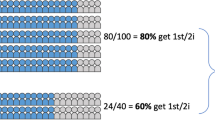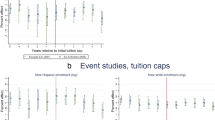Abstract
In an effort to enhance the efficiency and effectiveness of higher education, some governments have redefined their funding relationships with universities as contracts rather than grants in order to develop stronger incentives for university performance. This paper explores this approach, as adopted in Australia, within a principal agent framework. It examines the conditions necessary for success in achieving government objectives as well as preserving university autonomy.
Similar content being viewed by others
References
Boston, J. (1990). ‘The theoretical underpinnings of public sector restructuring in New Zealand’, in Boston, J.et al. (eds.) Reshaping the State: New Zeland's Bureaucratic Revolution. Auckland: Oxford University Press, pp. 1–26.
Chapman, B. (1988). ‘An economic analysis of the higher education contribution scheme of the Wran report’, Discussion Paper No. 196, Centre for Economic Policy Research, Australian National University.
Dawkins, J.S. (1988). Higher Education: A Policy Discussion Paper.
DeHoog, R. (1990). ‘Competition, negotiation, or cooperation’, Administration and Society 22(3), 317–340.
Eisenhardt, K. (1989). ‘Agency theory: An assessment and review’, Academy of Management Review 14(1), 57–74.
Ferris, J. (forthcoming 1992). ‘Higher education ‘reform’ in Australia: An outsider's view’, Australian Journal of Public Administration.
Ferris, J. (1992). ‘Contracting and higher education’, Journal of Higher Education 62, 1–24.
Geiger, R. (1986). Private Sectors in Higher Education. Ann Arbor: University of Michigan Press.
Harrold, R. (1990). ‘Profiles and performance indicators in Australian higher education resource allocation’, Educational Review 42(2), 189–196.
Harman, G. (1983). ‘Defining the issues in university-government relations: Mapping the shifting loci of effective power’, in Anwyl, J.E. (ed.), University Government Relations. Australian Vice-Chancellors' Committee, Occasional Paper No. 5.
Harman, G. and Meek, V.L. (1988). ‘Australian Higher Education Reconstructed?’, in Harman, G. and Meek, V.L. (eds.) Department of Administrative and Higher Education Studies.
James, E. (1990). ‘Decision processes and priorities in higher education’, in Hoenack, S. and Collins, E. (eds.), The Economics of American Universities, Management, Operations and the Fiscal Environment. Albany: SUNY Press, pp. 77–106.
Levy, D. (1986). ‘Alternative private-public blands in higher education finance: International patterns’, in Levy, D. (ed.), Private Education: Studies in Choice and Public Policy. New York: Oxford University Press, pp. 195–213.
Marshall, N. (1991). ‘Tertiary Education’, in Galligan, B., Hughes, O. and Walsh, C. (eds.), Intergovernmental Relations and Public Policy. Sydney: Allen and Unwin, pp. 214–225.
Moe, T. (1984). ‘The New Economies of Organization’, American Journal of Political Science.
Stone, D. (1990). ‘Private Higher Education in Australia’, Higher Education 20, 143–159.
Williams, B. (1988). Systems of Higher Education: Australia. New York: Interbook for the International Council for Educational Development.
Author information
Authors and Affiliations
Rights and permissions
About this article
Cite this article
Ferris, J.M. A contractual approach to higher education performance: with an application to Australia. High Educ 24, 503–516 (1992). https://doi.org/10.1007/BF00137245
Issue Date:
DOI: https://doi.org/10.1007/BF00137245




